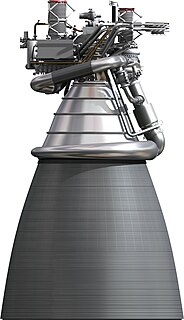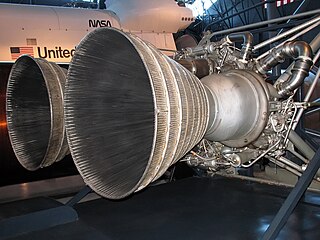Related Research Articles

The Centaur is a family of rocket propelled upper stages currently produced by U.S. launch service provider United Launch Alliance, with one main active version and one version under development. The 3.05 m (10.0 ft) diameter Common Centaur/Centaur III (as referenced in the infobox) flies as the upper stage of the Atlas V launch vehicle, and the 5.4 m (18 ft) diameter Centaur V is being developed as the upper stage of ULA's new Vulcan rocket. Centaur was the first rocket stage to use liquid hydrogen (LH2) and liquid oxygen (LOX) propellants, a high-energy combination that is ideal for upper stages but has significant handling difficulties.

The expander cycle is a power cycle of a bipropellant rocket engine. In this cycle, the fuel is used to cool the engine's combustion chamber, picking up heat and changing phase. The now heated and gaseous fuel then powers the turbine that drives the engine's fuel and oxidizer pumps before being injected into the combustion chamber and burned.

Rocketdyne was an American rocket engine design and production company headquartered in Canoga Park, in the western San Fernando Valley of suburban Los Angeles, in southern California.

Delta is an American versatile family of expendable launch systems that has provided space launch capability in the United States since 1960. Japan also launched license-built derivatives from 1975 to 1992. More than 300 Delta rockets have been launched with a 95% success rate. Only the Delta IV Heavy rocket remains in use as of November 2020. Delta rockets are currently manufactured and launched by the United Launch Alliance.

The Aerojet Rocketdyne RS-25, also known as the Space Shuttle Main Engine (SSME), is a liquid-fuel cryogenic rocket engine that was used on NASA's Space Shuttle. NASA is planning to continue using the RS-25 on the Space Shuttle's successor, the Space Launch System (SLS).

The F-1, commonly known as Rocketdyne F1, is a rocket engine developed by Rocketdyne. This engine uses a gas-generator cycle developed in the United States in the late 1950s and was used in the Saturn V rocket in the 1960s and early 1970s. Five F-1 engines were used in the S-IC first stage of each Saturn V, which served as the main launch vehicle of the Apollo program. The F-1 remains the most powerful single combustion chamber liquid-propellant rocket engine ever developed.

The J-2 was a liquid-fuel cryogenic rocket engine used on NASA's Saturn IB and Saturn V launch vehicles. Built in the U.S. by Rocketdyne, the J-2 burned cryogenic liquid hydrogen (LH2) and liquid oxygen (LOX) propellants, with each engine producing 1,033.1 kN (232,250 lbf) of thrust in vacuum. The engine's preliminary design dates back to recommendations of the 1959 Silverstein Committee. Rocketdyne won approval to develop the J-2 in June 1960 and the first flight, AS-201, occurred on 26 February 1966. The J-2 underwent several minor upgrades over its operational history to improve the engine's performance, with two major upgrade programs, the de Laval nozzle-type J-2S and aerospike-type J-2T, which were cancelled after the conclusion of the Apollo program.

The RL10 is a liquid-fuel cryogenic rocket engine built in the United States by Aerojet Rocketdyne that burns cryogenic liquid hydrogen and liquid oxygen propellants. Modern versions produce up to 110 kN (24,729 lbf) of thrust per engine in vacuum. Three RL10 versions are in production for the Centaur upper stage of the Atlas V and the DCSS of the Delta IV. Three more versions are in development for the Exploration Upper Stage of the Space Launch System and the Centaur V of the Vulcan rocket.

The staged combustion cycle is a power cycle of a bipropellant rocket engine. In the staged combustion cycle, propellant flows through multiple combustion chambers, and is thus combusted in stages. The main advantage relative to other rocket engine power cycles is high fuel efficiency, measured through specific impulse, while its main disadvantage is engineering complexity.

The Aerojet M-1 was the largest and most powerful liquid-hydrogen-fueled liquid-fuel rocket engine to be designed and component-tested. The M-1 offered a baseline thrust of 6.67 MN and an immediate growth target of 8 MN. If built, the M-1 would have been larger and more efficient than the famed F-1 that powered the first stage of the Saturn V rocket to the Moon.

The J-2X is a liquid-fueled cryogenic rocket engine that was planned for use on the Ares rockets of NASA's Constellation program, and later the Space Launch System. Built in the United States by Aerojet Rocketdyne, the J-2X burns cryogenic liquid hydrogen and liquid oxygen propellants, with each engine producing 1,307 kN (294,000 lbf) of thrust in vacuum at a specific impulse (Isp) of 448 seconds (4.39 km/s). The engine's mass is approximately 2,470 kg, significantly heavier than its predecessors.

The LE-5 liquid rocket engine and its derivative models were developed in Japan to meet the need for an upper stage propulsion system for the H-I and H-II series of launch vehicles. It is a bipropellant design, using LH2 and LOX. Primary design and production work was carried out by Mitsubishi Heavy Industries. In terms of liquid rockets, it is a fairly small engine, both in size and thrust output, being in the 89 kN (20,000 lbf) and the more recent models the 130 kN (30,000 lbf) thrust class. The motor is capable of multiple restarts, due to a spark ignition system as opposed to the single use pyrotechnic or hypergolic igniters commonly used on some contemporary engines. Though rated for up to 16 starts and 40+ minutes of firing time, on the H-II the engine is considered expendable, being used for one flight and jettisoned. It is sometimes started only once for a nine-minute burn, but in missions to GTO the engine is often fired a second time to inject the payload into the higher orbit after a temporary low Earth orbit has been established.
The RL60 was a planned liquid-fuel cryogenic rocket engine designed in the United States by Pratt & Whitney, burning cryogenic liquid hydrogen and liquid oxygen propellants. The engine runs on an expander cycle, running the turbopumps with waste heat absorbed from the main combustion process. This high-efficiency, waste heat based combustion cycle combined with the high-performance liquid hydrogen fuel enables the engine to reach a very high specific impulse of up to 465 seconds in a vacuum. The engine was planned to be a more capable successor to the Aerojet Rocketdyne RL10, providing improved performance and efficiency while maintaining the installation envelope of the RL10.

A cryogenic rocket engine is a rocket engine that uses a cryogenic fuel and oxidizer; that is, both its fuel and oxidizer are gases which have been liquefied and are stored at very low temperatures. These highly efficient engines were first flown on the US Atlas-Centaur and were one of the main factors of NASA's success in reaching the Moon by the Saturn V rocket.

The LR87 was an American liquid-propellant rocket engine used on the first stages of Titan intercontinental ballistic missiles and launch vehicles. Composed of twin motors with separate combustion chambers and turbopump machinery, it is considered a single unit. The LR87 first flew in 1959.

The Delta Cryogenic Second Stage (DCSS) is a family of cryogenic rocket stages used on the Delta III and Delta IV rockets, and which is planned to be used on the Space Launch System Block 1. The stage consists of a cylindrical liquid hydrogen (LH2) tank structurally separated from an oblate spheroid liquid oxygen (LOX) tank. The LH2 tank cylinder carries payload launch loads, while the LOX tank and engine are suspended below within the rocket's inter-stage. The stage is powered by a single Aerojet Rocketdyne-Pratt & Whitney RL10B-2 engine, which features an extendable carbon-carbon nozzle to improve specific impulse.

Pratt & Whitney Rocketdyne (PWR) was an American company that designed and produced rocket engines that use liquid propellants. It was a division of Pratt & Whitney, a fully owned subsidiary of United Technologies Corporation. It was headquartered in Canoga Park, Los Angeles, California. In 2013, the company was sold to GenCorp, becoming part of Aerojet Rocketdyne.

The BE-3 is a LH2/LOX rocket engine developed by Blue Origin.

Aerojet Rocketdyne is an American rocket and missile propulsion manufacturer. Headquartered in Sacramento, California, the company is owned by Aerojet Rocketdyne Holdings. Aerojet Rocketdyne was formed in 2013 when Aerojet and Pratt & Whitney Rocketdyne were merged, following the latter's acquisition by GenCorp from Pratt & Whitney. On April 27, 2015, the name of the holding company, GenCorp, was changed from GenCorp, Inc. to Aerojet Rocketdyne Holdings, Inc. As part of a $4.4 billion acquisition, struck on December 20, 2020, Lockheed Martin is to take over Aerojet Rocketdyne in the second half of 2021, pending regulatory approvals. On February 17, 2021, Raytheon objected to the acquisition, citing a reduction of competition for rocket boosters impacting the company's supply line.

The Exploration Upper Stage (EUS) is being developed as a large second stage for Block 1B and Block 2 of the Space Launch System (SLS), succeeding Block 1's Interim Cryogenic Propulsion Stage. It will be powered by four RL10C-3 engines burning liquid oxygen and liquid hydrogen to produce a total thrust of 433.1 kN (97,360 lbf). As of October 2017, the SLS Block 1B will have a payload capacity to low Earth orbit of 105 t and Block 2 will have a payload capacity of 130 t. The EUS is expected to first fly on Artemis IV in March 2026.
References
- 1 2 3 4 5 6 7 8 9 10 "MB-60". www.astronautix.com. Retrieved 2021-03-29.
- 1 2 3 4 5 6 7 8 Sack, William; Watanabe, Julie; Atsumi, Masahiro; Nakanishi, Hidemasa (2003-07-20). "Development Progress of MB-XX Cryogenic Upper Stage Rocket Engine". 39th AIAA/ASME/SAE/ASEE Joint Propulsion Conference and Exhibit. Huntsville, Alabama: American Institute of Aeronautics and Astronautics. doi:10.2514/6.2003-4486. ISBN 978-1-62410-098-7.
- ↑ Sack, William F. et al. “The MB-60 Cryogenic Upper Stage Engine - A World Class Propulsion System.” (2009).
- ↑ "Mitsubishi Heavy Industries, Ltd. Global Website | MB-XX". Mitsubishi Heavy Industries, Ltd. Archived from the original on 25 January 2021. Retrieved 2021-03-30.
- ↑ Gebhardt, Chris (2013-11-14). "SLS upper stage proposals reveal increasing payload-to-destination options". NASASpaceFlight.com. Retrieved 2021-03-29.
- ↑ "MB-60 JAXA 60,000 lbf thrust in-space engine for NASA SLS". forum.nasaspaceflight.com. Retrieved 2021-03-29.
- ↑ "NASA Technical Reports Server (NTRS)". ntrs.nasa.gov. Retrieved 2021-03-29.
- ↑ Mohon, Lee (2016-10-21). "Proven Engine Packs Big, In-Space Punch for NASA's SLS Rocket". NASA. Retrieved 2021-03-29.